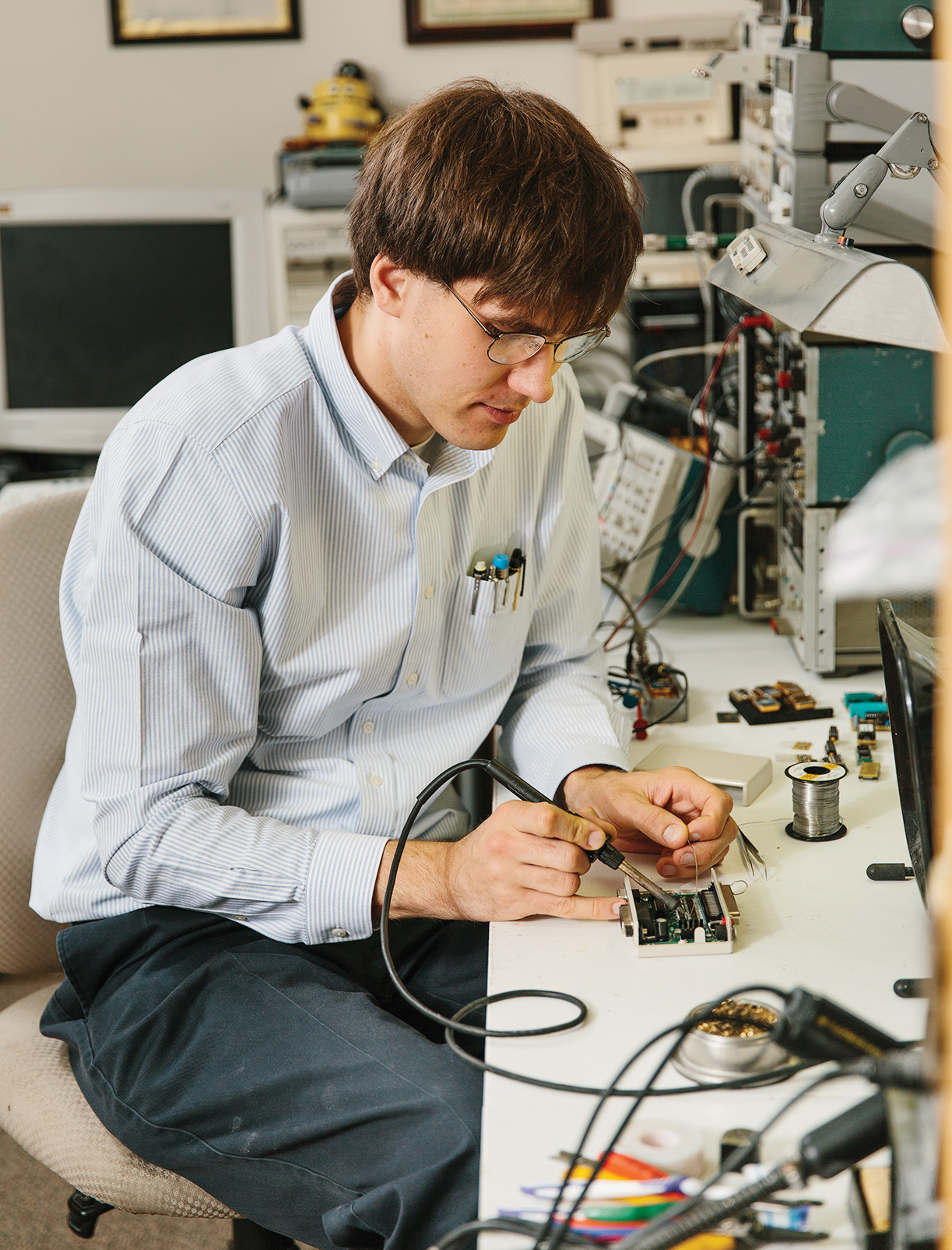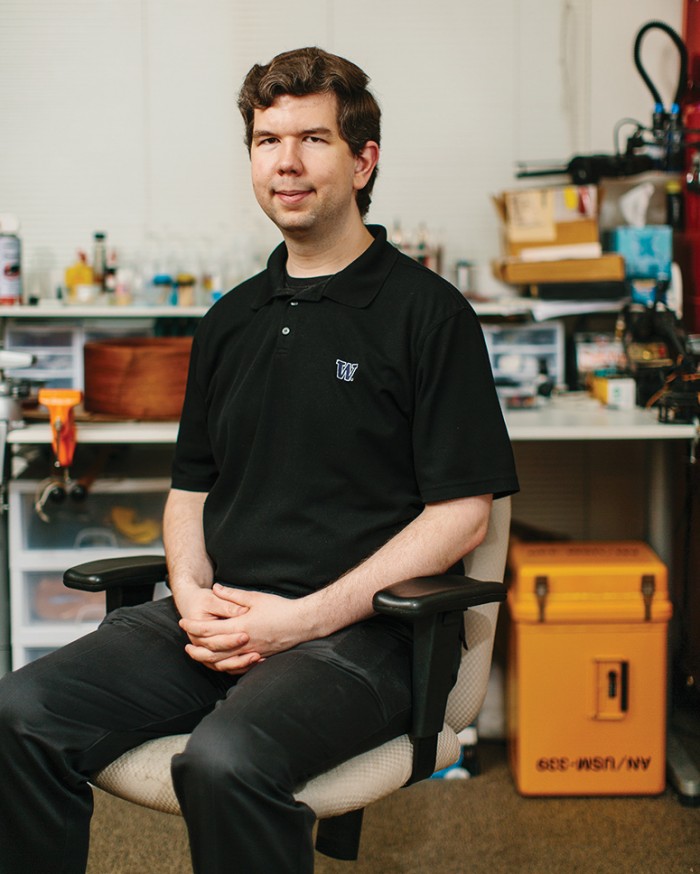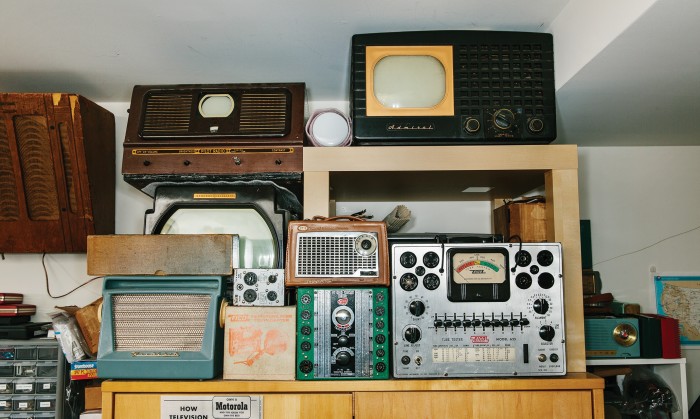A Dormitory Laboratory

Graduate students Matthew D’Asaro and Mark Chilenski have lived in the same two-bedroom suite in MIT’s Sidney-Pacific dormitory since September of 2010. They have the standard dorm room furniture—twin beds, bookcases, austere desks and chairs—but their suite is far from ordinary. Whether building Geiger counters or designing a new kind of ice cream maker, D’Asaro and Chilenski use their dorm as a workshop as much as a living space.
D’Asaro, a doctoral student in the Department of Electrical Engineering and Computer Science, dismantled his first electronic gadget as a toddler. He says one of his earliest memories is of taking apart his grandfather’s 1950s stereo system when he was five years old.

“I remember just lying on the carpet mesmerized,” he says. The vacuum tube inside the stereo “was this amazing device that glowed with this warm comforting glow and was electronic and seemed to be completely magic.”
By the fifth grade, he’d assembled a small collection of vintage electronics that he eventually learned to repair and operate. In high school, he bought a vacuum-tube television, which he finally got working again by the time he finished college. His parents had the case refinished as a graduation present. “I never could understand how transistors ever took off,” he jokes.
A Seattle native, D’Asaro attended the University of Washington, where he and Chilenski met in their freshman calculus class. The two remained close friends throughout college and decided to live together when they both came to MIT as grad students.
A thin and towering six-foot-six, D’Asaro wears wire-rimmed glasses and a pocket protector, and although he’s doing his dissertation on flexible and stretchable electronics, his passion for the rigid antiques that filled his childhood remains strong.
“By studying the entire spectrum of electronics from the inception to the present, you know the field with a far greater depth and perspective than someone who’s only aware of how things are done now,” he says.
Standing in the middle of his bedroom—a kind of time capsule of electrical engineering—D’Asaro smiles and cracks jokes as he tells stories from his childhood. He has spools of wire hanging on the wall to his left and a workbench cluttered with test equipment lining the wall to his right. Scattered all around are his old-school treasures—a 1946 Philco radio/phonograph, vintage manual cameras, a 1940s telephone that connects to his smartphone through a “slightly modified converter box,” a personal computer from the 1970s, a working TV from 1949. He even has prototypes of one of the world’s first integrated circuits, which he says his late grandfather, a former physicist at Bell Telephone Laboratories and a major influence in D’Asaro’s life, designed himself.

He also has piles of outdated lab tools that had been destined for the dumpster. “It’s MIT, so old equipment sort of falls down like rain around here if you know who to ask,” he says with a chuckle.
Chilenski’s room, by comparison, is relatively uncluttered. A percussionist in the MIT Wind Ensemble, he has been refurbishing and building his own drums since high school. It’s a months-long process that requires a lot of waiting for parts to dry, he says, gesturing to the roughly one-foot-wide drum that’s been sitting on his desk for weeks. Petroleum-based drying chemicals would speed up the process, he says, but they would also stink up the suite. Fortunately, the shellac he uses is dissolved in alcohol, so it “doesn’t smell any worse than a bad night at the bar.”
On his shelves, he has a Cold War–era Geiger counter as well as a collection of counters that he designed and built himself, the most recent of which D’Asaro collaborated on. Chilenski, who is working on a PhD in nuclear engineering, teaches prospective undergraduates in the field how to build the devices as a way to recruit them to the program.
The roommates are both busy with dissertation research, so they don’t have time to collaborate on many extracurricular projects. After more than a year of tinkering, however, they did manage to resuscitate an old 3-D printer that they heard was up for grabs outside a lab at MIT. D’Asaro snagged it after bounding up five flights of stairs to get there ahead of anyone riding the elevator.
Now their dorm days are numbered. Chilenski is on track to finish his dissertation in 2015. And although D’Asaro probably won’t graduate until 2016, he too will have to leave by year’s end, since Sidney-Pacific is scheduled for renovations.
“This is just about the peak and just about the end,” D’Asaro says. He hopes to get a job on the West Coast working with analog electronics, and Chilenski wants to end up at a national laboratory.
But the two have at least one more project to finish before they go—the ice cream maker sitting on their kitchen floor. They’re collaborating with D’Asaro’s younger sister, a local food entrepreneur, to modify the machine to dispense soft-serve with what D’Asaro calls a “special surprise.” Although they aren’t ready to say more about it, they’re convinced the result will be worth the hours spent tinkering in their dorm-room workshop.
Keep Reading
Most Popular
Large language models can do jaw-dropping things. But nobody knows exactly why.
And that's a problem. Figuring it out is one of the biggest scientific puzzles of our time and a crucial step towards controlling more powerful future models.
How scientists traced a mysterious covid case back to six toilets
When wastewater surveillance turns into a hunt for a single infected individual, the ethics get tricky.
The problem with plug-in hybrids? Their drivers.
Plug-in hybrids are often sold as a transition to EVs, but new data from Europe shows we’re still underestimating the emissions they produce.
Google DeepMind’s new generative model makes Super Mario–like games from scratch
Genie learns how to control games by watching hours and hours of video. It could help train next-gen robots too.
Stay connected
Get the latest updates from
MIT Technology Review
Discover special offers, top stories, upcoming events, and more.